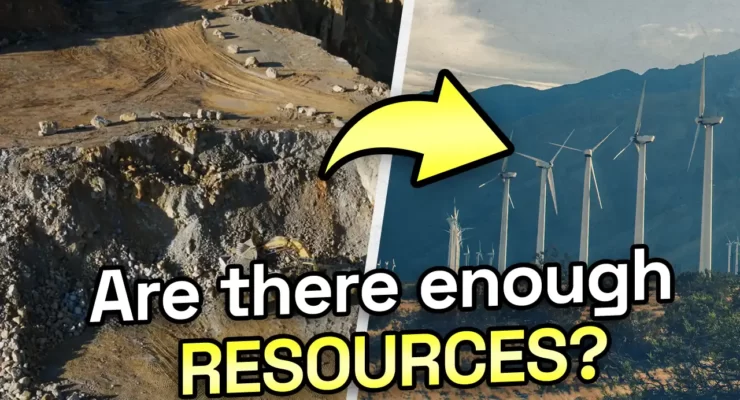Fast read
Future energy mix projections indicate that renewable energy sources like solar and wind will play a significant role. Although raw materials like silicon, aluminium, and glass are needed for solar technology. They are also plentiful and recyclable, so there should be enough to supply the rising demand for solar energy.
The growing demand for copper is driving the growth of the electricity industry and the switch to electric vehicles is the biggest obstacle in the transition to complete renewable energy.
However, it is anticipated that there will be enough copper to supply this demand with careful planning and investment in new resources.
Do we have enough raw materials to make the earth self-sustainable with renewables?
Nowadays, many experts are expecting solar and wind energy to become the answer to the world’s energy problems. While wave energy and hydro can also contribute, wave energy is still not robust enough and not accessible by all countries. Hydro also requires a high level of water resources, which few governments have.
This leaves wind and solar as the most available renewable resources. Many specialists have identified the vast benefits of solar, predicting it may become the first choice for energy soon.
With constant improvements in photovoltaic cell technology, decreasing costs and increasing efficiency. Solar will inevitably be a dominant force in the energy footprint of the future.
What raw materials are in solar panels?
Solar PV technology requires substantial raw materials such as silicon, aluminium, and glass. The question then arises – if solar panel systems increase in popularity and more people worldwide adopt a solar system, will there be enough of these raw materials to keep up with the increasing demand?
In short, the answer is yes, but there are also challenges.
We have enough raw materials to produce billions of solar panels
What many people don’t realise is that solar production is relatively straightforward. Almost all the raw materials involved in production are abundant and relatively eco-friendly.
So let’s look at the major components in detail:
The tempered glass layer
Most of a solar panel’s weight comes from glass, which is essential for letting in light while protecting the solar cells. This glass is made using silicon, and since silicon comes from sand, which is abundant, we don’t have to worry much about the availability of glass for solar panels.
However, as more people use solar panels, the companies making glass might need to produce more each year to keep up with the demand for raw materials. So, it’s important for the glass industry to make enough glass to support the growing use of solar energy.

Aluminium rails and framing
This raw material is the third most abundant material on the earth. At the same time, it requires high energy to produce. Not in short supply and has excellent recyclable properties.
Aluminium makes up 8% of the earth’s crust so there is no fear of this raw material running out because of solar panel production.
Silicon to solar panel manufacturing process
Silicon is used to create wafers, the foundation of solar pv cells. However, like glass, it comes from sand, the second most abundant element, with 26% of the earth’s crust containing silicon.
Silver is used in electrical connections such as busbars
This raw material is used in small amounts in solar panels. Panel producers have reduced the silver used in solar panels even more through innovation over the years. Technologies are already available to replace silver as a component should any shortage arise in future years.
Copper is the Achilles heel of the renewable energy industry
Each year roughly 20 million tonnes of copper is mined. Of this number, the solar industry uses around 420,000 tonnes a year or about 2%. This clearly shows how little the solar industry impacts the supply of this raw material.
Nevertheless, the demand for copper, being the cheapest conductive material, is estimated to increase up to 10-fold.
This is happening because we are transitioning from fossil fuels to renewable energy sources for electricity. The new systems are smaller and scattered. For example, consider all the new cables required to connect solar and wind farms to the grid.
Also, the transition from combustion engines to EVs will increase the need for a more expanded grid, which means more demand for copper. Finding enough new deposits in areas that are accessible and have stable governments will be a challenge.
Potentially the lack of copper could be the biggest obstacle in our path to the energy transition. Unfortunately, it seems governments worldwide have not realised this risk fully, and so far, their projected new investment in finding fresh copper resources is limited.
Given that the development of new mines takes many years, this issue can potentially become a major one in future years.

What can we do?
With nearly 80% of the weight of solar panels attributed to aluminium and glass, and both being recyclable materials, it appears that we’re not facing significant limitations on resources for the growth of solar energy. Despite some barriers hindering us from achieving 100% renewable energy, raw materials, apart from copper, are not a prominent obstacle. In the event that copper supply faces challenges, alternative metals and alloys could potentially substitute, albeit at a higher cost.
In the unlikely scenario where the listed raw materials begin to experience shortages, recycling emerges as a logical and sustainable solution. Recycling not only addresses potential supply issues but also aligns with eco-friendly practices.
Reclaiming and reusing aluminium and glass from decommissioned solar panels not only reduces waste but also lessens the dependence on new raw materials. The solar industry can keep growing and be environmentally responsible by recycling solar panel materials.
This is important when there are supply challenges. Recycling helps the industry to continue its growth. It also allows it to be environmentally friendly.
